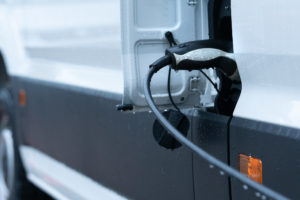Commercial fleets still see numerous challenges when switching to e-mobility. One of them in particular is charge planning. But is that such a big deal? Let’s take a look!
It’s clear that the shift for transport companies to electric vehicles will be a massive contribution toward a sustainable climate. And it also makes more and more economic sense for fleet professionals to make the transition. After all, the transportation sector accounts for 37% of global GHG-emissions — with 5% from commercial transport alone.
Yet an old problem persists: today’s commercial fleets have an operating model that’s built around the good ol’ gas it & go combustion engine. So fleet professionals expect their drivers to cover a certain number of kilometers during the permitted driving time. After all, the entire delivery business revolves around one thing — quick deliveries.
Does an eLCV fleet meet the expectations for driving the necessary distances on time?
At first, a fleet with combustion engines seems more reliable. As soon as the tank is empty, the drivers simply fill it up again. Right now, some fleet managers look at the capabilities of electric vehicles and see only two things:
- A limited range — anywhere between 200 and 400 km.
- Long charging times that cannot be done during working hours.
We can immediately eliminate the first concern: delivery services in cities usually only cover distances of 50–150 km per day. No problem for today’s eLCV vans or even eHDV trucks — and no need for range anxiety. But to ensure that recharging batteries doesn’t interfere with day-to-day business, EV charge planning must be compatible with:
- Transportation plans of the fleet
- Company’s charging infrastructure
- eLCVs & eHDVs while they’re on the road
It all comes down to the right EV charge plan
For transport companies to successfully transition to an electrified fleet, it makes sense to analyze & integrate their operating models. This way they find ways to ensure that charging times don’t clash with core working hours or delivery schedules. This is particularly important for food distribution services, as they often supply perishable goods. It would be a disaster if a supplier of fish broke down with his EV in the middle of the route and had to watch helplessly as the ice melted.
However, fleet managers will quickly realize that these worries are completely unfounded with the right EV charge planning.
4 things fleet managers need to know when setting up an EV charge plan
Before fleet managers start with EV charge planning, they need the following information about their eLCVs:
- Energy demand for the next tour(s)
- State of charge of the vehicle battery (SoC)
- Electric vehicle charging stations available
- Energy grid capacity constraints
This overview allows data-driven planning of charging opportunity windows, the necessary energy input per truck, as well as the charging location and time. Additionally, all information must fit into the fleet manager’s transport planning system as well as account for possible changes in traffic or other unplanned events.
Data control — the solution to your charging concerns
Many fleet professionals have already started building a charging infrastructure along their warehouse networks. This provides the charging capacity needed for the entire EV fleet. Using high-performance, top-of-the-line DC chargers, they offer electricity rates for charging large batteries of over 300 kW in their EVs. However, if you’re an EV expert, you know that even with that power, the charging stations take around two hours to fully charge a battery. And if you’re a fleet manager, you’re now wondering: where and when will I be able to charge my fleet?
“Good question,” we say, but it’s not that much of an issue. Production facilities have been meeting a range of customer needs while staying within capacity constraints for years — through proper planning and scheduling. Why shouldn’t this also work for EV charge plans? To achieve this, keep these things in mind:
- The transportation plan represents the energy demand of the vehicle.
- The charging infrastructure and its capabilities.
- The grid’s power constraints and the energy costs — as they vary throughout the day.
- How the EVs are consuming their battery energy, when they will return to the warehouse location, and what the SoC will be upon their return.
But you don’t have to keep track of all that data all the time when software can do the job for you!
How do you benefit from the introduction of an EV charge planning tool?
PANION Charging can take autopilot control of your fleet data to optimize charging operations. It also provides you with real-time information on your vehicle & charger assets with a super responsive charge plan. Of course, you are always in control and in the loop on:
- Which vehicle to charge,
- on which charger,
- at what time,
- and for how long.
All this is necessary to ensure the stability required to perform complex business operations and meet delivery requirements on time. This ensures that the batteries have sufficient charge for each upcoming tour. The software also considers the charging curves to charge quickly as well as cost-effectively.
With PANION Charging as your EV charge planner, your fleet EVs are consistently supplied with the necessary energy and your drivers are always connected via an app. They know when and where they need to charge the EV and can use their breaks or loading and unloading times to do so.
No worries!




